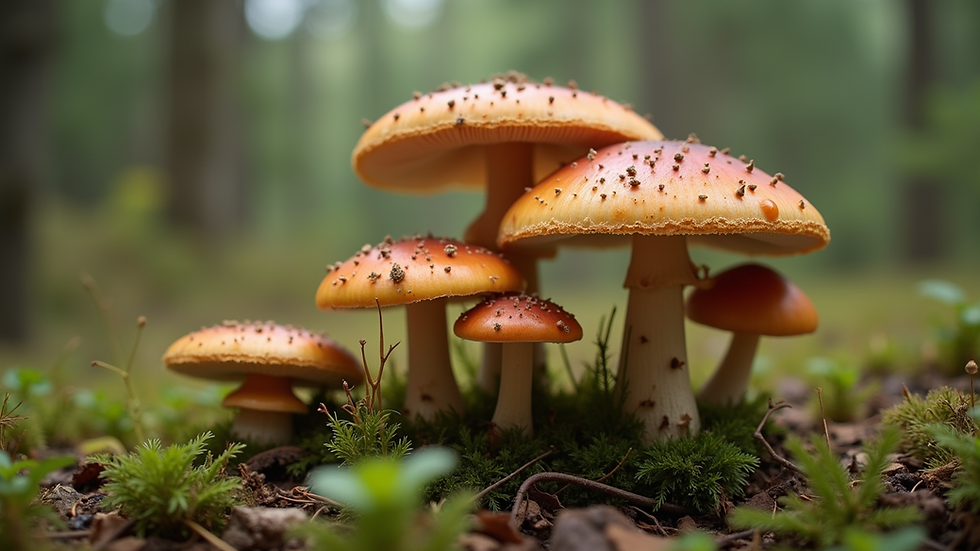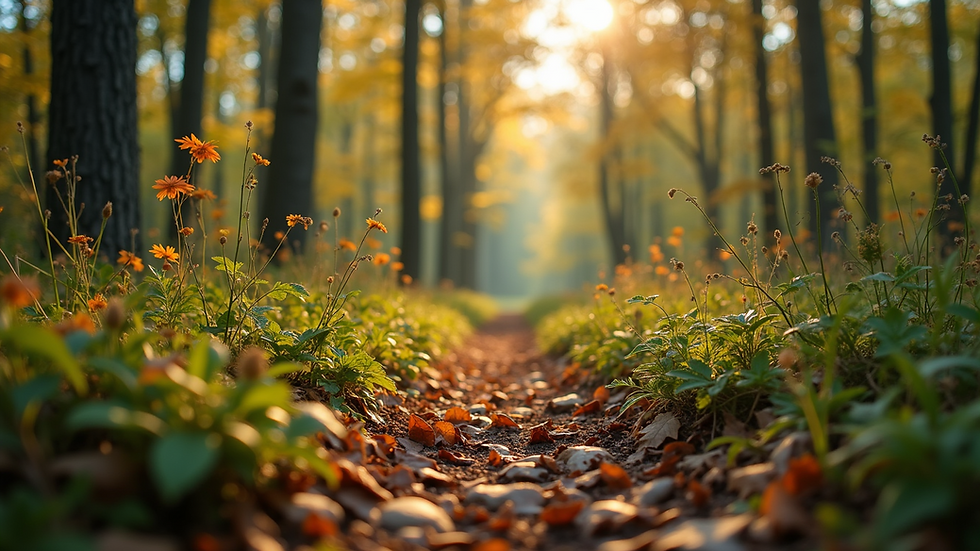Exploring Autumn's Bounty: Safe Ethical Foraging for Mushrooms Nuts and Wild Herbs
- Jo Keirns

- Sep 21
- 4 min read
As leaves turn golden and the crisp air settles in, autumn calls us to explore our natural surroundings. This season offers more than cozy sweaters and pumpkin spice lattes; it’s a perfect time for foraging. Gathering mushrooms, nuts, and wild herbs can bring us closer to nature’s riches. However, foraging requires a focus on safety and ethics. This blog post will guide you through the art of foraging while reflecting on the spiritual insights we can gain from the wonders of nature.
Understanding Foraging
Foraging involves seeking and gathering wild food resources. It has enriched human existence for thousands of years, serving as a vital source of nourishment and fostering a deeper bond with our environment. In autumn, edible plants and fungi flourish, making this the ideal time to embrace foraging.
However, it’s important to approach this activity with caution. Many wild plants and mushrooms can be toxic. Knowledge is essential for safe foraging.
The Importance of Education
Before setting out to forage, take time to learn about the plant and mushroom species in your area. Books, reputable online resources, and local foraging communities can be incredibly helpful. Consider attending workshops or guided foraging tours led by experienced individuals. Research shows that participants in structured foraging classes feel more confident and tend to correctly identify species 90% of the time.
By learning more, you ensure your safety while also fostering appreciation for the ecosystem. Understanding the role each species plays within its environment can significantly enhance your foraging adventure.
Image Placeholder

Safe Foraging Practices
Your safety should be your foremost concern when foraging. Here are some key tips to remember:
1. Know Your Species
Familiarize yourself with the edible species found locally. Use field guides or mobile apps to help identify plants and mushrooms. Investigate their specific traits, like color, shape, and habitat.
2. Avoid Contaminated Areas
Choose foraging sites away from pollution zones, pesticides, and herbicides. Steer clear of locations near roadsides or industrial areas to minimize health risks.
3. Harvest Responsibly
When foraging, take only what you need. This keeps the ecosystem balanced and allows others to enjoy the same resources. An effective guideline is the “one-third rule,” which suggests taking only one-third of what you find to leave enough for wildlife and future foragers.
4. Use Proper Tools
Make sure you have the right tools for foraging. Bring a small knife, a sturdy basket or cloth bag, and a field guide. Avoid plastic bags, which can trap moisture and cause spoilage.
5. Be Mindful of the Environment
Respect the natural habitat. Stay on established paths to minimize your impact, and avoid trampling plants or disturbing wildlife.
Image Placeholder

Foraging for Autumn Edibles
With safety outlined, let's dive into some delicious autumn edibles to forage.
Mushrooms
Autumn is prime for mushroom hunting. Varieties such as chanterelles, porcini, and morels peak in season. However, correctly identifying edible mushrooms from toxic varieties is crucial.
Identifying Edible Mushrooms
Chanterelles: These vibrant, golden mushrooms have a fruity scent and are usually found in coniferous forests. A tip for identification is their unique v-shaped gills.
Porcini: Renowned for their rich, nutty flavor, porcini mushrooms have a thick stem and a brown cap. They commonly grow near trees like pines and oaks.
Morels: With their distinctive honeycomb appearance, morels are a sought-after treat. They typically grow in wooded areas throughout the spring and fall.
Nuts
Autumn also brings a bounty of nuts. Acorns, chestnuts, and walnuts can be gathered responsibly.
Harvesting Nuts
Acorns: Raw acorns are not usually fit for consumption due to their tannin levels, but they can be processed into flour or leached to reduce bitterness.
Chestnuts: These tasty nuts are covered by spiky husks. Ensure you only collect edible varieties, as some may be toxic.
Walnuts: Look for black walnuts or English walnuts. Their outer husk can be messy, so gloves are a good idea when handling them.
Wild Herbs
Wild herbs are another treasure to discover in the autumn landscape. Foraging for these can enhance your meals while promoting health benefits.
Common Wild Herbs
Nettle: High in nutrients, nettles can be used in soups, teas, or steamed like spinach.
Dandelion: Every part of the dandelion is edible, from roots to flowers. Use them in salads, herbal teas, or even homemade wine.
Wild Garlic: With its mild garlic flavor, this herb enhances many dishes. Look for its distinctive smell and broad leaves to identify it.
Image Placeholder

Spiritual Insights from Foraging
Foraging extends beyond food gathering; it can also be a journey of spiritual discovery. Immersing ourselves in nature reveals God's creativity in the delicate details of plants and ecosystems.
Connection to Creation
Engaging in foraging deepens our connection with creation. Each mushroom, nut, and herb tells a story of life, interdependence, and growth. Gathering these gifts reminds us of our place in nature and our duty to care for it.
Mindfulness and Presence
The act of foraging fosters mindfulness. Walking through the woods encourages us to notice the colors, sounds, and scents surrounding us. This awareness can lead to moments of gratitude and reflection, enhancing our spiritual connection.
Community and Sharing
Foraging can bring people together. Sharing your discoveries with family and friends encourages conversations about nature and sustainability. It highlights that we can support one another as we explore God's creation.
Embracing the Autumn Adventure
As autumn unfolds, take time to explore the season's bounty through safe and ethical foraging. By educating yourself, practicing responsible gathering, and connecting with nature, you can savor the gifts of the earth while reflecting on the spiritual lessons they offer.
Foraging is not just about acquiring food. It is a chance to appreciate the beauty of the world around us and encounter the creativity of the Divine. So grab your basket, venture into the woods, and embrace the adventure awaiting you this autumn.
Happy foraging!












Comments